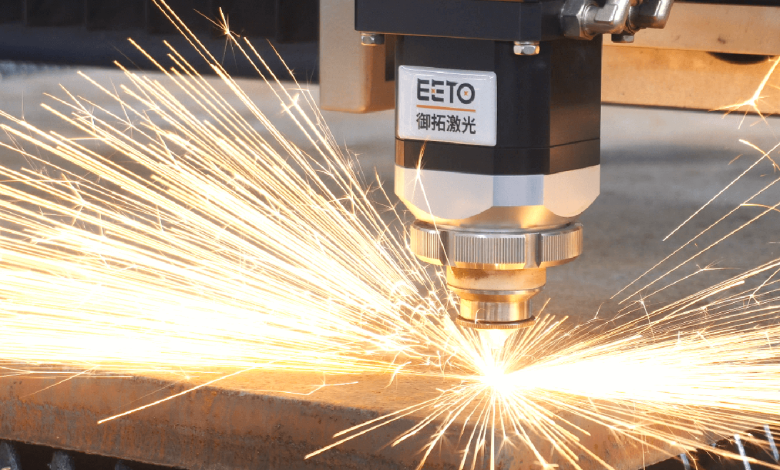How Does A Laser Cutting Machine Work?

Laser cutting machine is a type of automatic laser system with CNC controller. Which adopts CO2 or FIBER laser beam to cut metals (steel, copper, brass, aluminum, gold, silver, alloy, iron), acrylic, rubber, wood, plastic, leather, paper, foam, textile, fabric into 2D/3D shapes and profiles.
A laser is a highly concentrated beam of light of a single wavelength. At each wavelength of light, various materials absorb, reflect and transmit that light in varying amounts.
What is the laser beam
A laser beam is a very high intensity beam of light with only one wavelength, or one color. In the case of a typical CO2 laser, that wavelength is in the infrared part of the spectrum, so it is invisible to the human eye. As the beam travels from the laser resonator that generates the beam through the beam path of the laser cutter. It is only about 3/4 of an inch in diameter. It may be bounced in a different direction by some mirrors or “beam benders” before it is finally focused on the plate. The focused laser beam passes through a hole in a nozzle before hitting the plate. Also flowing through this nozzle hole is a compressed gas, such as oxygen or nitrogen.
The high power density results in rapid heating, melting and partial or complete vaporization of the material. When cutting mild steel, the laser beam is hot enough to initiate a typical “oxy-fuel” combustion process where the laser cutting gas will be pure oxygen, just like an oxy-fuel torch. When cutting stainless steel or aluminum, the laser beam simply melts the material and then blows the molten metal out of the cut with high-pressure nitrogen gas.
In a laser cutting machine
The laser cutting head moves over the sheet metal in the shape of the desired part, thus cutting the part from the sheet metal. The capacitive height control system maintains a very precise distance between the end of the nozzle and the sheet being cut. This distance is important because it determines the position of the focal point relative to the surface of the plate. By raising or lowering the focal point from above. On or below the surface of the plate, the quality of the cut can be influenced.
Laser cutting machines work by focusing a laser beam onto a piece of material. The laser is so powerful that when focused. It raises the temperature of the material to be cut high enough to melt or vaporize the material in the small area where the beam is focused. Often, an auxiliary gas is used to help propel the melted material away from the cutting area. This is especially true for cutting metals or thick materials like plywood.
To cut the shape, the laser head is moved, using some form of gantry to position the beam over the new material, resulting in a line being cut rather than a small pinhole. Types of motion systems include rack and pinion, ball screws and linear motors. Linear motors are the most expensive, but the fastest and most accurate. Racks and pinions offer nearly the same speed and accuracy, but are less expensive. Some small amateur lasers may also use timing belts and stepper motors to move the laser head. In all cases, a system with service and encoder feedback greatly improves the accuracy of the laser cutting system. As does a rigid frame, isolated from vibration.
For laser cutting operations
It is important to choose a wavelength that is highly absorbent in the material you intend to cut.
When laser energy hits the surface of a material, the material absorbs a large amount of energy and heats up rapidly, exceeding its melting temperature and reaching its degradation temperature.
At the degradation temperature, the material decomposes and disintegrates. Usually, when this happens, smoke or fumes are released. The cut edges may be heated to a lower level and actually melt and reorganize. This can actually be useful as a sealing mechanism for fibrous materials, for example, to prevent threading.
When working with a laser cutter, it is best to adjust the laser to an angle so that the fumes generated during the cutting process do not collect on the laser as soot. In addition, when cutting (or welding) highly reflective surfaces. It is important to prevent the laser beam from reflecting off the surface and onto the laser. Which could damage the laser.
What are the advantages of metal laser cutting machine?
Metal laser cutting machine can obtain the advantages of excellent laser beam quality, high efficiency, high speed, easy operation, low cost, low maintenance, stable operation, and ultra-flexible optics. Metal laser cutting machines are easy to meet flexible industrial manufacturing requirements.
1. High precision and optimum stability. Adopting high precision ball screw drive mechanism and optimized CNC system control. It can meet the processing of precision parts with stable dynamic performance and long term working.
2. High quality of cutting part. Adopting mechanical follow-up cutting head system. The cutter head follows the height of the plate and always keeps the position of the cutting point to make the cutting seam smooth.
3. 3. High performance. For thin plate cutting, it can replace CO2 laser cutting machine, CNC punching machine and shearing machine, and the cost of the whole laser metal cutting machine is equivalent to 1/4 of CO2 laser cutting machine and 1/2 of CNC punching machine.
4. Low cost of use and high cutting speed.




